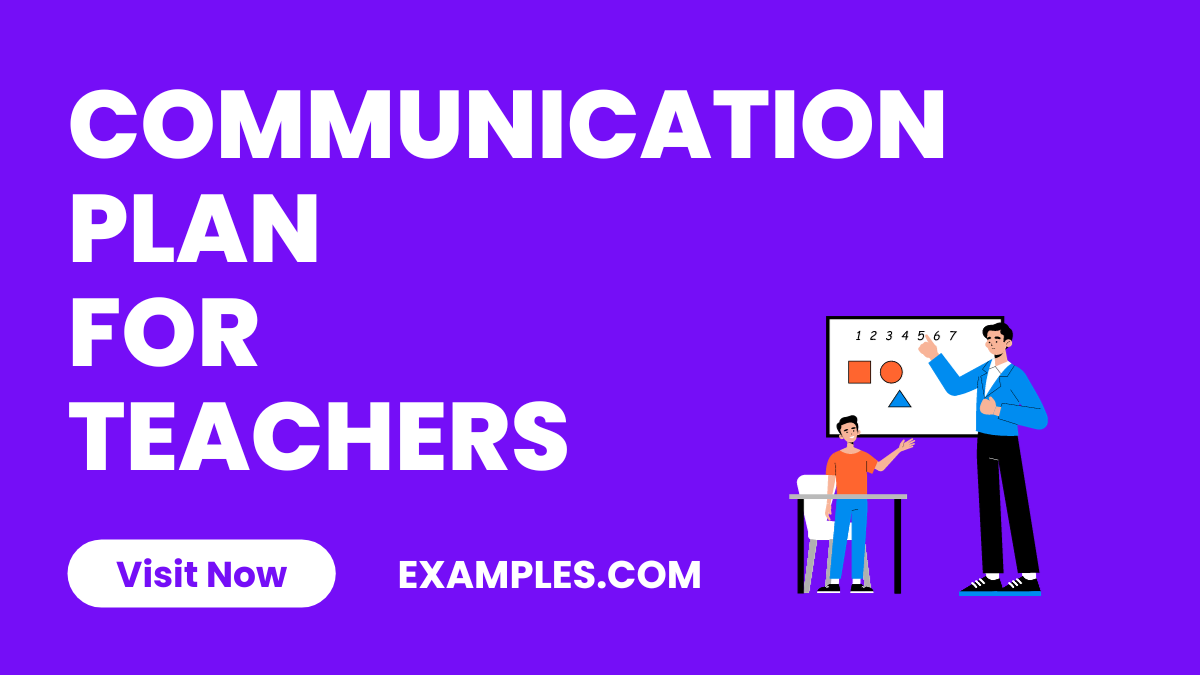5+ Communication Plan for Teachers Examples
The Communication Plan for Teachers guide is an essential resource for educators seeking to enhance classroom interaction and understanding. This comprehensive guide offers a variety of communication examples tailored for educational settings, enabling teachers to effectively convey concepts and manage classroom dynamics. It includes practical examples and strategies to address common communication challenges in education, fostering a more engaged and responsive learning environment. By integrating these techniques, teachers can significantly improve student-teacher interactions and educational outcomes.
Download Communication Plan for Teachers Bundle
Communication Plan for Teachers
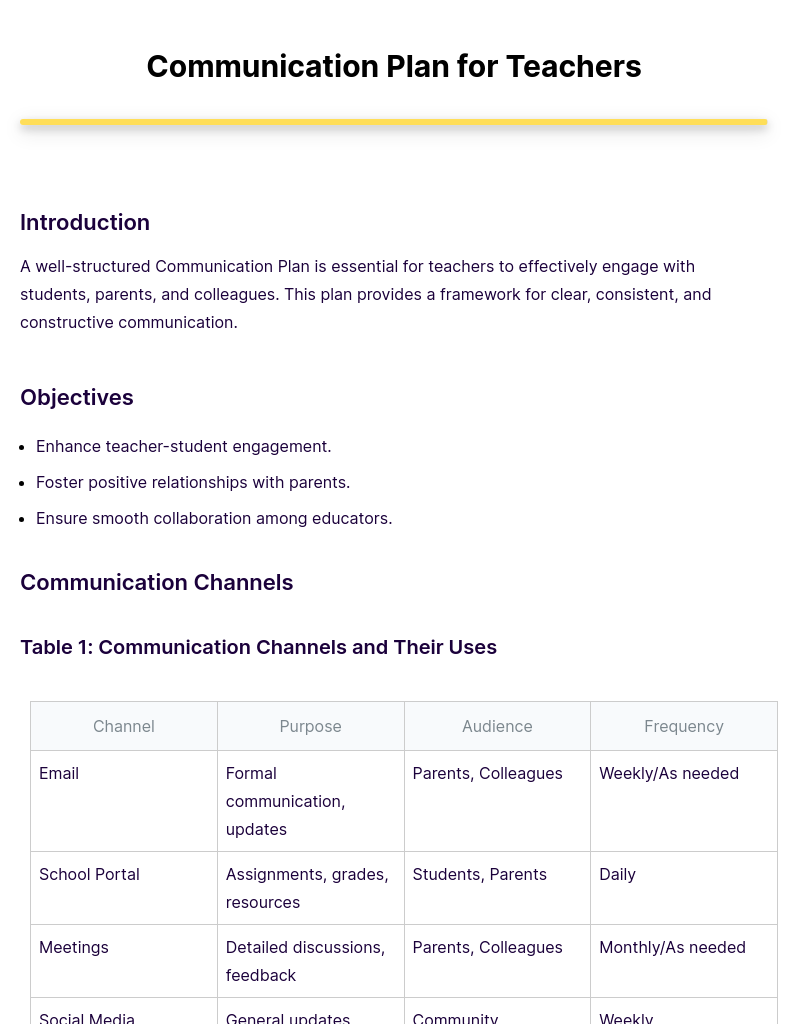
The Communication Plans for Teachers invaluable resource for educators. It offers a range of strategies and techniques for effective classroom communication. The guide focuses on enhancing teacher-student engagement, fostering positive relationships with parents, and ensuring smooth collaboration among educators. It also delves into various communication channels like email communication, school portals, and meetings, providing practical advice on how to utilize them effectively. This resource is a must-read for teachers aiming to create a more dynamic and responsive educational environment.
Parent Communication Plan for Teachers
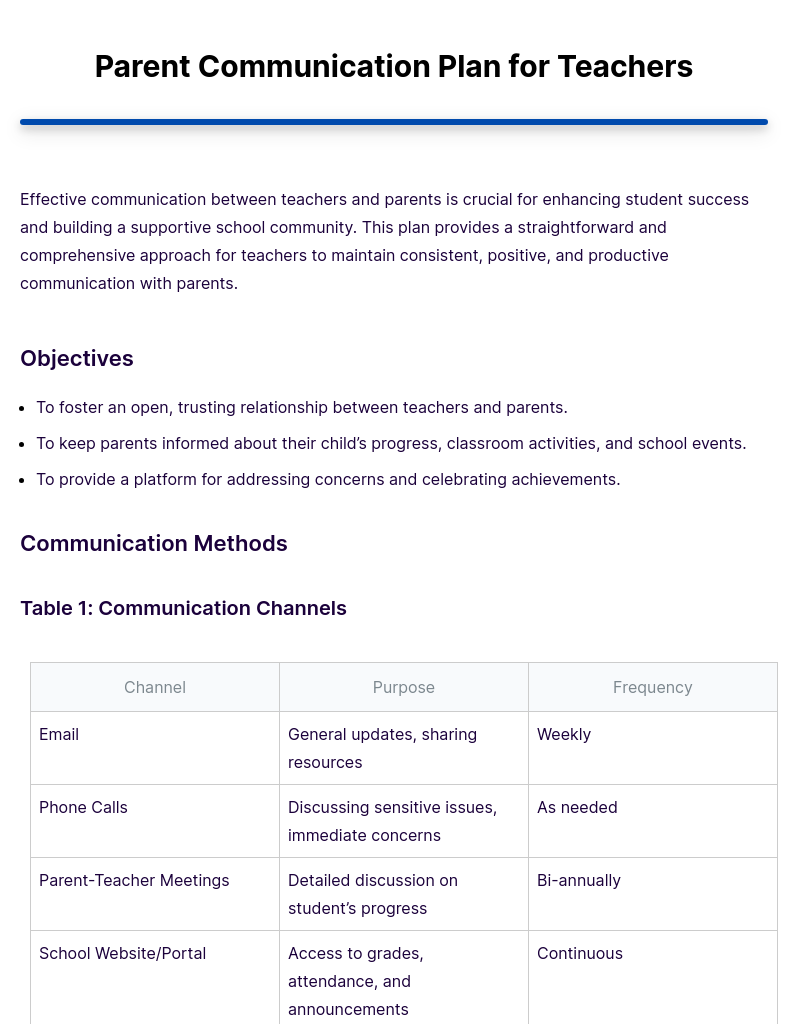
The article Parent Communication Plan for Teachers offers a strategic approach for teachers to effectively communicate with parents. It emphasizes the importance of clear, consistent communication and includes practical methods to foster a positive and collaborative relationship between teachers and parents. The guide covers various aspects such as setting objectives, choosing communication channels, and engaging parents in their child’s education process. It serves as an invaluable resource for teachers seeking to enhance parental involvement and student success.
Student Communication Plan for Teachers
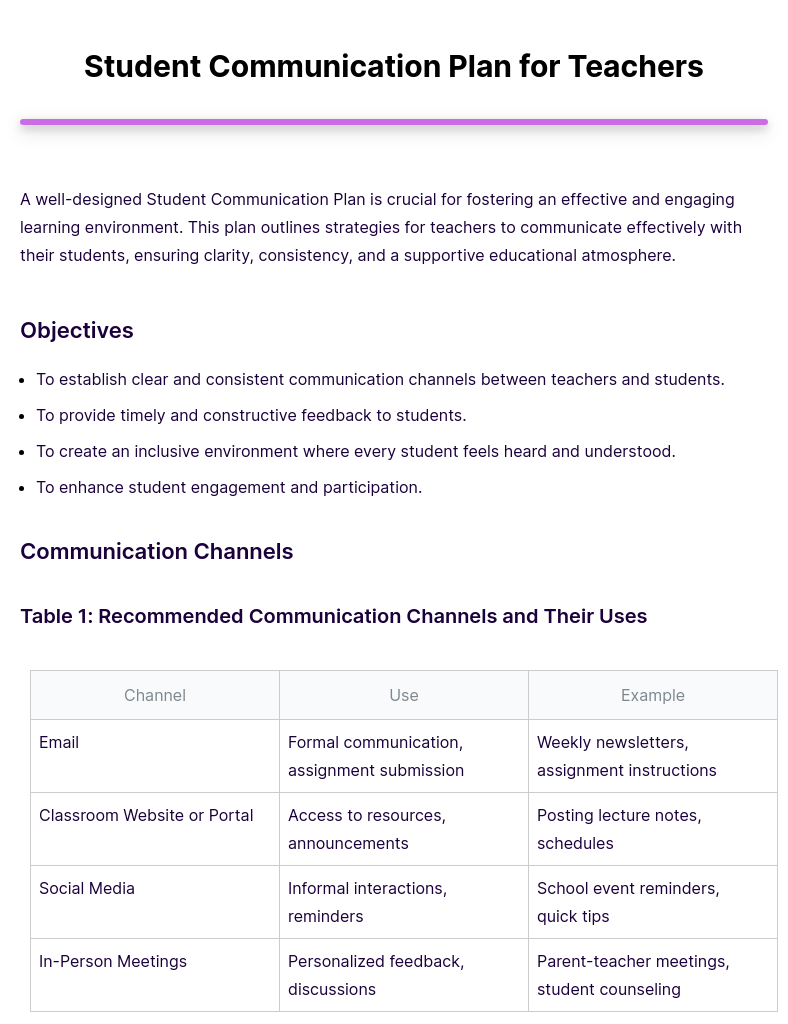
The Student Communication Plan for Teachers” offers strategies for effective teacher-student interaction. This plan highlights the importance of establishing clear communication channels, providing constructive feedback, and creating an inclusive environment. It includes practical examples such as using email for formal communication and social media for informal interactions. The guide emphasizes regular assessments, cultural sensitivity, and differentiated instruction to meet diverse student needs. This resource is valuable for teachers aiming to enhance student engagement and participation
Education Communication Plan for Teachers
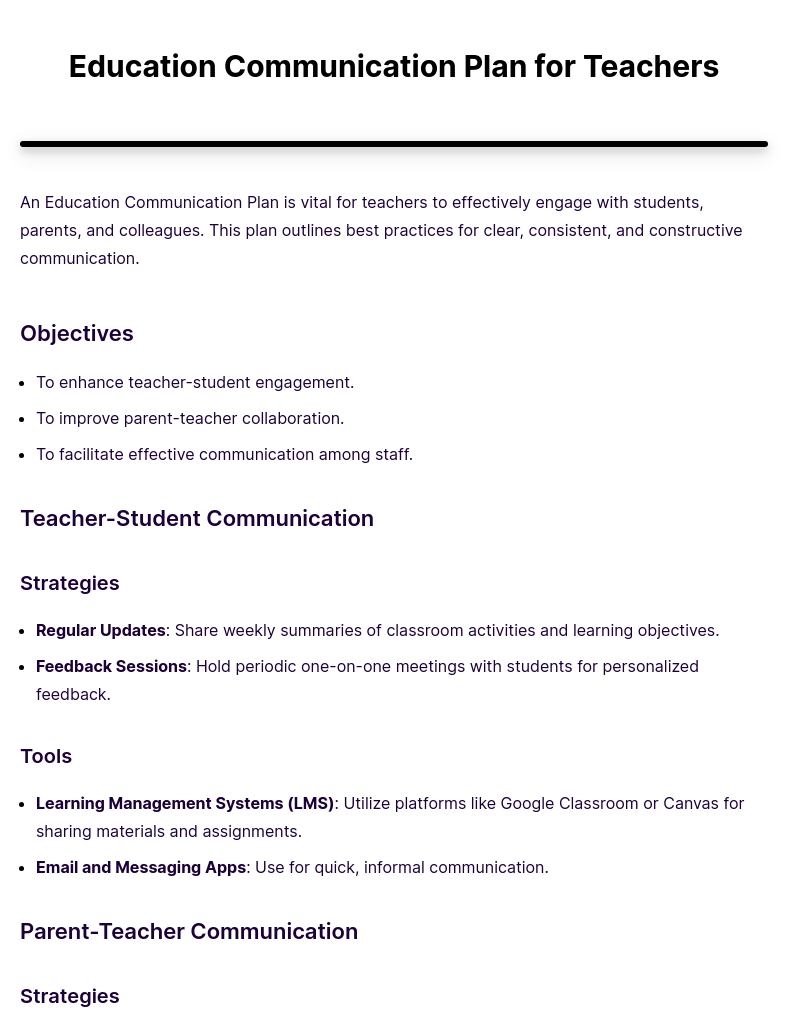
The Education Communication Plan for Teachers offers a detailed guide for effective communication in educational settings. It highlights strategies for enhancing teacher-student engagement, improving parent-teacher collaboration, and facilitating efficient communication for staff . The guide includes practical methods like regular updates, feedback sessions, and the use of various communication tools. It provides a structured approach for educators to optimize their interaction with students, parents, and colleagues, contributing to a positive learning environment.
Teacher Parent Communication Plan Example
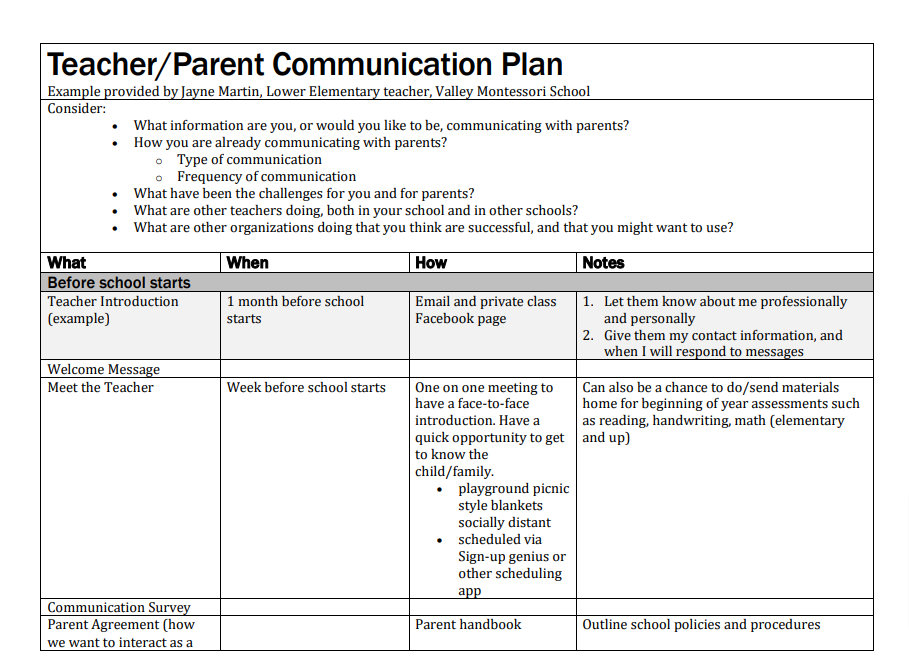
amshq.org
DownloadSteps to Constructive Parent-Teacher Communication Plan
- Regular Updates: Share regular academic progress updates.
Example: “Your child showed great improvement in mathematics this term.” - Feedback Sessions: Schedule periodic one-on-one meetings.
Example: “Let’s discuss your child’s learning style and progress next Thursday.” - Open Communication Channels: Establish an open line for queries and concerns.
Example: “Feel free to email me any time about your child’s homework.” - Parental Involvement: Encourage parent involvement in school activities.
Example: “We’d love to have you join our science fair planning committee.” - Clear Expectations: Set clear expectations from the start.
Example: “It’s important for students to complete their assignments on time.” - Positive Reinforcement: Share positive feedback about the student.
- Example: “Your child made a thoughtful contribution in our class discussion today.”
- Cultural Sensitivity: Respect and acknowledge diverse backgrounds.
Example: “I’m interested in incorporating cultural elements that resonate with your family in our lessons.” - Conflict Resolution: Address and resolve conflicts promptly.
Example: “Let’s find a solution together that works best for your child. - Educational Resources: Provide resources for parental support.
Example: “This book might give you some great insights into helping with reading at home.” - Collaborative Goals: Work together to set academic goals.
Example: “Let’s set a goal to improve reading skills by the end of the semester.
Communication Plan Tips for Teachers
- Establish Clear Goals: Define specific objectives for your communication, like enhancing student participation.
Example: “This year, I aim to encourage every student to contribute in class discussions.” - Know Your Audience: Tailor your communication style to suit different audiences – students, parents, colleagues.
Example: “For parent meetings, I use less technical language and more examples.” - Choose Appropriate Channels: Select the most effective channels for your messages, such as emails, newsletters, or face-to-face meetings. Example: “I use newsletters for general updates and emails for personal communications.”
- Be Consistent and Regular: Communicate on a regular schedule to establish reliability. Example: “Every Monday, I send out a weekly update to parents.”
- Encourage Open Dialogue: Create an environment where students and parents feel comfortable to share feedback.
Example: “I always ask for student input at the end of each lesson.” - Use Positive Language: Focus on using positive and encouraging language.
Example: “I highlight what students did well before suggesting improvements.” - Be Culturally Sensitive: Respect the diverse cultural backgrounds of your students and their families. Example: “I incorporate diverse cultural examples in my lessons.”
- Provide Clear Instructions: Ensure that your instructions are clear and easy to understand. Example: “I use step-by-step guides for assignments.”
- Utilize Technology: Incorporate modern technology like educational apps or platforms for enhanced interaction.
Example: “I use educational apps for interactive learning activities.” - Feedback Mechanism: Implement a system for receiving and incorporating feedback. Example: “I have an anonymous feedback box in my classroom.”
Creating an effective Communication Plan for Teachers involves strategic planning and implementation. Here are 10 strategies with examples:
- Active Listening: Show genuine interest in student feedback.
Example: “I noticed you seemed unsure about the last topic. Can you tell me more about what was unclear?” - Open-Door Policy: Encourage open communication with students and parents.
Example: “Feel free to come to me with any concerns or questions you might have.” - Regular Updates: Keep parents informed about classroom activities and student progress. Example: “This week, we explored photosynthesis, and your child showed keen interest.”
- Positive Reinforcement: Acknowledge student achievements.
Example: “I was impressed with how well you presented your science project today.” - Cultural Inclusivity: Incorporate diverse perspectives in lessons.
Example: “Next week, we’ll explore stories from different cultures to understand various viewpoints.” - Technology Utilization: Leverage digital tools for effective communication.
Example: “Please check our class blog for weekly updates and resources.” - Collaborative Environment: Foster group activities to enhance communication among students.
Example: “Let’s work in groups to discuss our book’s themes.” - Parent Engagement: Involve parents in learning activities.
Example: “We invite you to share your career experience with the class next month” - Conflict Resolution: Address issues promptly and constructively.
Example: “I’ve noticed some tension during group work; let’s find a way to work together more effectively.” - Empathy and Understanding: Show empathy towards student challenges.
Example: “I understand that you’re finding this topic challenging. Let’s work through it together.”
How to Create Communication Plan for Teachers?
Creating an effective Communication Plan for Teachers involves several key steps to enhance classroom engagement and understanding:
- Assess Current Communication Methods: Evaluate your current methods and identify areas for improvement.
- Set Clear Objectives: Define specific goals, such as improving student engagement or enhancing feedback mechanisms.
- Choose Appropriate Communication Tools: Select tools that suit your classroom’s needs, whether digital platforms, traditional methods, or a blend of both.
- Develop a Communication Strategy: Outline how you will convey information, engage students, and receive feedback.
- Implement and Monitor: Put your plan into action and regularly assess its effectiveness, making adjustments as necessary.
By following these steps, teachers can create a comprehensive communication plan that fosters a more dynamic and responsive educational environment.
What are the Components of a Communication Plan for Teachers?
- Objective Setting: Define clear communication goals, such as improving student engagement or clarifying lesson objectives.
- Target Audience Identification: Understand the diverse needs of students and tailor communication accordingly.
- Message Development: Create clear, concise, and relevant messages suited to the educational context.
- Channels of Communication: Select appropriate channels, like classroom discussions, digital platforms, or parent-teacher meetings.
- Feedback Mechanisms: Implement systems to gather feedback from students and colleagues to continually refine communication strategies.
- Evaluation and Adaptation: Regularly assess the effectiveness of communication and make necessary adjustments.
The article on WGU’s Hey Teach website,”Tips for Successful Teacher-Parent Communication,” provides valuable insights into enhancing communication between teachers and parents. It emphasizes setting boundaries, being consistent, and utilizing technology to streamline communication. The article also offers practical tips on handling different types of parent interactions, including challenging situations, and underscores the importance of teacher-parent communication for student success. Strategies include using tools like Friday Folders, online platforms, and maintaining a balance between professional and personal boundaries.
Walden University’s Ways to Improve Parent-Teacher Communication” offers practical tips for effective communication in elementary education. It emphasizes the importance of positivity, regular updates, and trust-building between teachers and parents. The guide includes suggestions like being warm in interactions, communicating often, and understanding diverse family backgrounds. These strategies are designed to enhance parent-teacher relationships, ultimately benefiting student learning and development.



